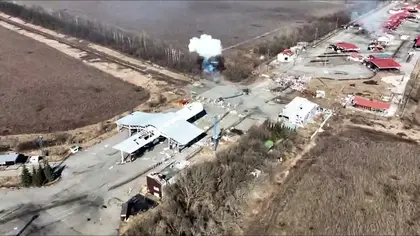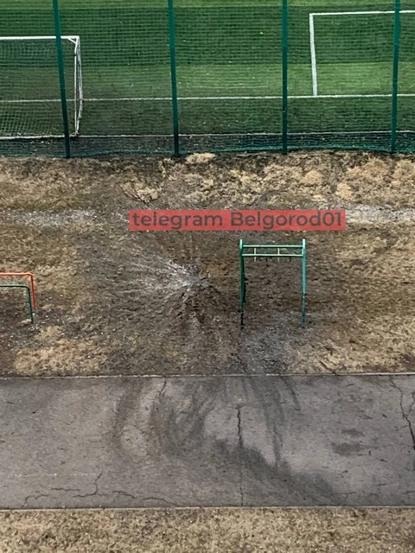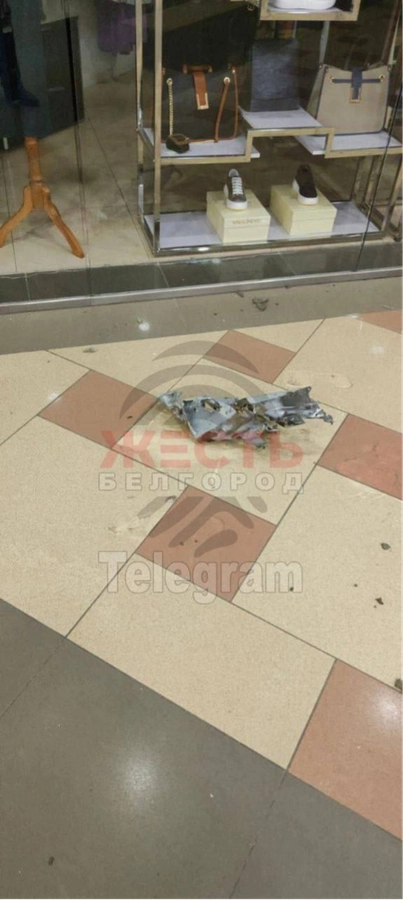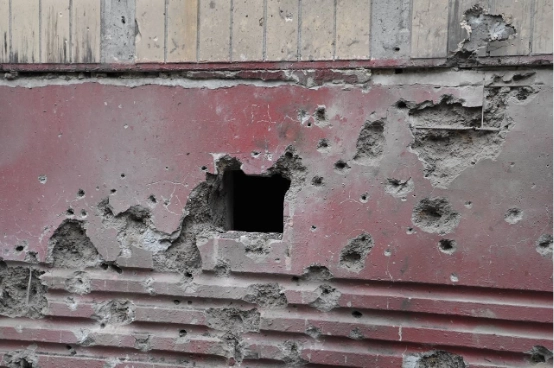This weeks’ cross-border fighting in western Russia between Kremlin military forces and anti-Putin Russian citizens has spread rumors and made claims across multiple sources and outlets. Here are the five key things you should know to be the most well-informed you can be for now.
JOIN US ON TELEGRAM
Follow our coverage of the war on the @Kyivpost_official.
Russian social media March 14 photograph of a probable 122mm rocket explosion on pavement in the west Russian city Belgorod. Source is the Telegram channel Belgorod01.
What’s confirmed
- Volunteer fighters from three anti-Putin organizations called the Russian Volunteer Corps (RDK), the Freedom of Russia Legion (LSR) and Siberian Battalion crossed the Ukraine-Russia border at no fewer than three locations on Tuesday.
- All three groups say they are Russian citizens fighting for freedom in their country. As with previous cross-border raids, this latest round of attacks by anti-Kremlin forces into Russian Federation territory was openly supported by Ukrainian military.
- Each of the raiding groups appears to have numbered between 50 and 150 fighters, plus support troops. The raids are neither a few infiltrators nor a major ground attack.
- The Russians fought back first with border troops, regular army infantry and Lancet FPV drones, later artillery. By Thursday afternoon air strikes were documented.
- The cross-border attacks triggered firefights near the village Tetkino in Russia’s Kursk Oblast, and the villages Sporadushino and Kozinka in Russia’s Belgorod Oblast.
- There was a helicopter landing near the village Kozinka. Two Mi-8-loads of raider infantry entered the village but after firing left.
- As of Friday, the raiders were still at large and combat was taking place outside Sporadushino and Kozinka.
- Raider-operated tanks and armored personnel carriers were spotted around Sporadushino and Kozinka.
- Either the raiders or their Ukrainian supporters launched explosive drones and rocket artillery at the regional administrative center Belgorod.
- Russian authorities evacuated three regions adjacent to the fighting.
What the Russians are saying
- Russian state-controlled media and mil-bloggers are claiming the cross-border raids were absolutely demolished by local defenses.
- The most extravagant claim so far, from Russia’s Defense Ministry, asserted that from March 12 to 14 the cross-border attackers lost 500 dead, 1,000 seriously wounded, 18 tanks and 23 armored personnel carriers.
- The most substantial raid in the vicinity of Sporadushino was utterly smashed with indirect and direct fire, FPV drones and then artillery-delivered land mines dropped in the path of retreating enemy.
- Russian authorities have already uploaded to the internet drone video showing the destruction of two tanks, three armored personnel carriers and a raider casualty clearance point with fifteen soldiers, some medics, as evidence of the Russian victory.
Russian social media March 14 photograph of a probable 122mm rocket fragment lying on pavement in the west Russian city Belgorod. Source is the Telegram channel Belgorod Telegram.
- Among the raider vehicles destroyed were US-made Bradley infantry fighting vehicles. The raid may have numbered 3,000 men in total.
- The raider incursion is fully contained and being constantly attacked, and Russian army paratroopers are en route to the region and when they arrive the raiders will be wiped out.
- The Ukrainian military used a Czechia-produced Vampire long-range artillery rocket system to bombard Belgorod city randomly, but Russian army air defenses shot the rockets down.
- Russia could retaliate in kind but will not because Russia is a humanitarian country, per propagandist Sergey Kliuchenkov (better known as Sergey Mardan)
- The raids are part of a Kyiv strategy to discredit the Russian government and disrupt Presidential elections, March 15 through 17.
- That Ukrainian strategy will not work because the cross-border raids were shot to pieces and the Russian populace is resilient and supports democracy.
What the Raiders and the Ukrainians are saying
- The raids are ongoing, all raider groups are organized and remain on mission. Russian claims the raiders were demolished are false. Beyond admitting having taken casualties, they are saying nothing about their losses.
- A key objective of the raids, the destruction of a border checkpoint near the village of Grayvoron, was achieved with acceptable losses.
- At least ten Russian border troops attempting to defend the checkpoint surrendered and drone video showing them waving a white flag has already been uploaded to the internet.
- In general, the raids are going as planned and panic among Russian troops and civilian population is substantial.
- The great bulk of damage to civilian homes and businesses has been from Russian army units shelling or bombing Russian private property.
Russian social media March 14 photograph of strikes by anti-personnel slugs carried in the warhead of a 122mm rocket on the facade of a civilian building in the west Russian city Belgorod. Source is the Telegram channel Belgorod Telegram.
What seems pretty likely
- This is the largest cross-border incursion launched by Kyiv loyalist Russians since the start of the full-scale invasion
- Evidence points to an attack force of about 300-500 infantry split into at least three groups, and a similar number of support troops operating vehicles and support weapons.
- The raiders probably lost at least two or three armored personnel carriers and two tanks.
- The raiders probably lost at least around 10 dead and wounded.
- The Russians have declared the border incursions completely destroyed three days in a row.
- Belgorod was rocketed and the rockets did not hit military targets. Long-range drone strikes also took place. The overall count of strikes appears to be between 20-40 explosions.
- Damage in Belgorod has been limited by the standards of the Russo-Ukraine war, but at least five civilians were injured. One was probably killed.
- The Russian evacuation order, followed by a raider public appeal for civilians to move away from the fighting, was followed by the departure of 7-8,000 vehicles and close to 20,000 residents from their homes.
- The cross-border raids are part of a larger Ukrainian campaign to take the war to Russian territory. The centerpiece of that campaign is drone strikes on Russian oil refineries, with an oil refinery in central Russian Kaluga set on fire on Friday morning.
- In terms of Ukrainian priorities and damage to Russian war-making capacity, the cross-border raids are a secondary operation.
Latest Developments
- As of midday Friday, infantry firefights were in progress near the village Sporadushino, Belgorod Oblast, with both sides supporting troops with mortars, artillery and drones
- As of midday Friday, a firefight of undetermined scale was in progress near the village Popovo-Lezhachi, Kursk Oblast. The adjacent village Tetkino was under raider or Ukrainian mortar fire.
- Shortly after midday on Friday a salvo of rockets hit Belgorod, striking civilian buildings and streets.
You can also highlight the text and press Ctrl + Enter










